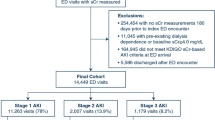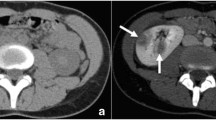Abstract
Finding reliable and easy-to-obtain predictors of severe infectious complications after shock wave lithotripsy (SWL) is a major clinical need, particular in symptom-free hydronephrosis. Therefore, we aim to prospectively investigate the predictive value of Hounsfield units (HU) in renal pelvis urine for the risk of severe infectious complications in patients with ureteral stones and symptom-free hydronephrosis after SWL. This multi-center prospective study was conducted from June 2020 to December 2023. The HU of renal pelvis urine was measured by non-enhanced computed tomography. The severe infectious complications included systemic inflammatory response syndrome, sepsis, and septic shock. Binary logistic regression models assessed the odds ratios (ORs) and 95% confidence intervals (CIs). Finally, 1,436 patients with ureteral stones were enrolled in this study. 8.9% (128/1,436) of patients experienced severe infectious complications after SWL treatment. After adjusting confounding variables, compared with the patients in the lowest renal pelvis urine density quartile, the OR (95% CI) for the highest quartile was 32.36 (13.32, 78.60). There was a positive linear association between the HU value of renal pelvis urine and the risk of severe infectious complications after SWL (P for trend < 0.001). Furthermore, this association was also observed stratified by age, gender, BMI, stone size, stone location and hydronephrosis grade (all P for interaction > 0.05). Additionally, the nonlinear association employed by restricted cubic splines is not statistically significant (nonlinear P = 0.256). The AUROC and 95%CI of renal pelvis urine density were 0.895 (0.862 to 0.927, P value < 0.001). The cut-off value was 12.0 HU with 78.59% sensitivity and 85.94% specificity. This multi-center prospective study demonstrated a positive linear association between HU in renal pelvis urine and the risk of severe infectious complications in patients with ureteral stones and symptom-free hydronephrosis after SWL, regardless of age, gender, BMI, stone size, stone location, and hydronephrosis grade. These findings might be helpful in the SWL treatment decision-making process.



Similar content being viewed by others
Data availability
Not applicable.
References
Reyner K, Heffner AC, Karvetski CH (2016) Urinary obstruction is an important complicating factor in patients with septic shock due to urinary infection. Am J Emerg Med 34(4):694–696
Wagenlehner FM, Pilatz A, Weidner W (2011) Urosepsis–from the view of the urologist. Int J Antimicrob Agents 38(Suppl):51–57
Brun-Buisson C (2000) The epidemiology of the systemic inflammatory response. Intensiv Care Med 26(Suppl 1):S64–S74
Basmaci I, Sefik E (2020) A novel use of attenuation value (Hounsfield unit) in non-contrast CT: diagnosis of pyonephrosis in obstructed systems. Int Urol Nephrol 52(1):9–14
Hinojosa-Gonzalez DE, Torres-Martinez M, Flores-Villalba E (2023) Emergent urinary decompression in acute stone-related urinary obstruction: a systematic review and meta-analysis. J Clin Urol 16(1):19–31
Müller-Mattheis VG, Schmale D, Seewald M, Rosin H, Ackermann R (1991) Bacteremia during extracorporeal shock wave lithotripsy of renal calculi. J Urol 146(3):733–736
Skolarikos A, Alivizatos G, de la Rosette J (2006) Extracorporeal shock wave lithotripsy 25 years later: complications and their prevention. Eur Urol 50(5):981–990
Bhojani N, Miller LE, Bhattacharyya S, Cutone B, Chew BH (2021) Risk factors for urosepsis after ureteroscopy for stone disease: a systematic review with meta-analysis. J Endourol 35(7):991–1000
De Coninck V, Keller EX, Somani B, Giusti G, Proietti S, Rodriguez-Socarras M, Rodríguez-Monsalve M, Doizi S, Ventimiglia E, Traxer O (2020) Complications of ureteroscopy: a complete overview. World J Urol 38(9):2147–2166
Seitz C, Desai M, Häcker A, Hakenberg OW, Liatsikos E, Nagele U, Tolley D (2012) Incidence, prevention, and management of complications following percutaneous nephrolitholapaxy. Eur Urol 61(1):146–158
Flores-Mireles AL, Walker JN, Caparon M, Hultgren SJ (2015) Urinary tract infections: epidemiology, mechanisms of infection and treatment options. Nat Rev Microbiol 13(5):269–284
Wagenlehner FME, Pilatz A, Weidner W, Naber KG (2015) Urosepsis: overview of the diagnostic and treatment challenges. Microbiol Spectr. https://doi.org/10.1128/microbiolspec.UTI-0003-2012
Tamburrini S, Lugarà M, Iannuzzi M, Cesaro E, De Simone F, Del Biondo D, Toto R, Iulia D, Marrone V, Faella P, Liguori C, Marano I (2021) Pyonephrosis ultrasound and computed tomography features: a pictorial review. Diagnostics (Basel, Switzerland) 11(2):331
Boeri L, Fulgheri I, Palmisano F, Lievore E, Lorusso V, Ripa F, D’Amico M, Spinelli MG, Salonia A, Carrafiello G, Montanari E (2020) Hounsfield unit attenuation value can differentiate pyonephrosis from hydronephrosis and predict septic complications in patients with obstructive uropathy. Sci Rep 10(1):18546
Gong Z, Li Y, Zhang H, Pan C, Li J, Liu G, Bai S (2023) Prospective comparison of extracorporeal shock wave lithotripsy and ureteroscopy in distal ureteral stones. Urolithiasis 51(1):86
Yin X, Li J, Pan C, Liu G, Li Z, Bai S (2023) Development and validation of a predictive model for stone-free failure after extracorporeal shockwave lithotripsy in patients with ureteral stone in a large prospective cohort. World J Urol 41(5):1431–1436
Sugino Y, Kato T, Furuya S, Sasaki T, Arima K, Sugimura Y (2020) The usefulness of the maximum Hounsfield units (HU) in predicting the shockwave lithotripsy outcome for ureteral stones and the proposal of novel indicators using the maximum HU. Urolithiasis 48(1):85–91
Levy MM, Fink MP, Marshall JC, Abraham E, Angus D, Cook D, Cohen J, Opal SM, Vincent JL, Ramsay G, SCCM/ESICM/ACCP/ATS/SIS (2003) 2001 SCCM/ESICM/ACCP/ATS/SIS International Sepsis Definitions Conference. Crit Care Med 31(4):1250–1256
Vincent JL, Moreno R, Takala J, Willatts S, De Mendonça A, Bruining H, Reinhart CK, Suter PM, Thijs LG (1996) The SOFA (Sepsis-related Organ Failure Assessment) score to describe organ dysfunction/failure. On behalf of the Working Group on Sepsis-Related Problems of the European Society of Intensive Care Medicine. Intensiv Care Med 22(7):707–710
Singer M, Deutschman CS, Seymour CW, Shankar-Hari M, Annane D, Bauer M, Bellomo R, Bernard GR, Chiche JD, Coopersmith CM, Hotchkiss RS, Levy MM, Marshall JC, Martin GS, Opal SM, Rubenfeld GD, van der Poll T, Vincent JL, Angus DC (2016) The third international consensus definitions for sepsis and septic shock (Sepsis-3). JAMA 315(8):801–810
Erdogan A, Sambel M, Caglayan V, Avci S (2020) Importance of the hounsfield unit value measured by computed tomography in the differentiation of hydronephrosis and pyonephrosis. Cureus 12(11):e11675
Yuruk E, Tuken M, Sulejman S, Colakerol A, Serefoglu EC, Sarica K, Muslumanoglu AY (2017) Computerized tomography attenuation values can be used to differentiate hydronephrosis from pyonephrosis. World J Urol 35(3):437–442
Wang X, Tang K, Xia D, Peng E, Li R, Liu H, Chen Z (2020) A novel comprehensive predictive model for obstructive pyonephrosis patients with upper urinary tract stones. Int J Clin Exp Pathol 13(11):2758–2766
Acknowledgements
We give special thanks to all the colleagues at the Department of Urology of Shengjing Hospital for their help and support. We thank International Science Editing for editing this manuscript. The authors would like to thank all of the study participants.
Funding
This study was financially supported by Liaoning Provincial Science and Technology Plan Joint Program (Application Basic Research Project; 2023021056-JH2/1017). The 345 Talent Project of Shengjing Hospital (M0713). These sponsors had no role in the study design; in the collection, analysis or interpretation of data; in the writing of the report; or in the decision to submit the article for publication.
Author information
Authors and Affiliations
Contributions
Song Bai had full access to all the data in the study and takes responsibility for the integrity of the data and the accuracy of the data analysis. Song Bai: Protocol/project development. Dongmei Liu, Junlong Liu, Zheming Li, Chengshan Ge, Hongqiang Guo, Shiyu Song, Zhenhua Li, and Song Bai: Data collection or management. Dongmei Liu, Junlong Liu, Zheming Li, Chengshan Ge, Hongqiang Guo, and Shiyu Song: Data analysis. Dongmei Liu, Junlong Liu, and Zheming Li: Manuscript writing/editing.
Corresponding authors
Ethics declarations
Conflict of interest
There is no conflict of interest. Song Bai declare that they have no competing interests.
Ethical approval
Ethical approval (2020PS521K) was provided by the Ethics Committee of Shengjing Hospital Affiliated China Medical University on 9 June 2020. Informed consent from all eligible subjects was obtained. The clinical research registry UIN is ChiCTR2000033789. The study protocol conformed to the ethical guidelines of the 1975 Declaration of Helsinki.
Consent for publication
Informed consent from all eligible patients was obtained.
Additional information
Publisher's Note
Springer Nature remains neutral with regard to jurisdictional claims in published maps and institutional affiliations.
Rights and permissions
Springer Nature or its licensor (e.g. a society or other partner) holds exclusive rights to this article under a publishing agreement with the author(s) or other rightsholder(s); author self-archiving of the accepted manuscript version of this article is solely governed by the terms of such publishing agreement and applicable law.
About this article
Cite this article
Liu, D., Liu, J., Li, Z. et al. The association between renal pelvis urine density and the risk of severe infectious complications in patient with symptom-free hydronephrosis after shock wave lithotripsy: a multi-center prospective study. Urolithiasis 52, 72 (2024). https://doi.org/10.1007/s00240-024-01572-5
Received:
Accepted:
Published:
DOI: https://doi.org/10.1007/s00240-024-01572-5




